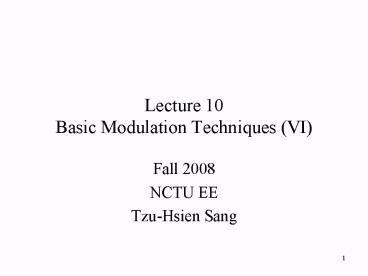Lecture 10 Basic Modulation Techniques (VI) - PowerPoint PPT Presentation
1 / 18
Title:
Lecture 10 Basic Modulation Techniques (VI)
Description:
One unfinished business: the Costas loop. It is very useful for carrier recovery in both analog and digital communication systems. ... – PowerPoint PPT presentation
Number of Views:562
Avg rating:3.0/5.0
Title: Lecture 10 Basic Modulation Techniques (VI)
1
Lecture 10Basic Modulation Techniques (VI)
- Fall 2008
- NCTU EE
- Tzu-Hsien Sang
1
1
2
Outlines
- Linear Modulation
- Angle Modulation
- Interference
- Feedback Demodulators
- Analog Pulse Modulation
- Delta Modulation and PCM
- Multiplexing
2
2
3
- One unfinished business the Costas loop. It is
very useful for carrier recovery in both analog
and digital communication systems.
4
Analog Pulse Modulation
- We now study the progression from techniques
dealing with pure waveforms ones for discrete
samples. - Historically, these methods are the early
attempts to achieve modern communications. They
are in the twilight zone between analog and
digital modulations. - Today, their spirits can be still found in
components such as ADC.
5
- Analog pulse modulation A pulse train is used as
the carrier wave. Some characteristic feature of
each pulse (e.g., amplitude, duration, or
position) is used to represent message samples. - PAM pulse amplitude
- PDM pulse duration
- PPM pulse position
- Digital Pulse Modulation Messages are
discrete-amplitude (finite levels) samples. - DM delta modulation
- PCM pulse-code modulation
6
(No Transcript)
7
PAM
8
- The conceptual demodulation scheme
- The idea of equalizer Anything that goes through
a known distortion can be recovered.
9
PWM
- Spectrum complicated (Fourier-Bessel spectra)
- Demodulation area of pulse. Low-pass
filtering (integration)
10
PPM
11
Delta Modulation
12
- Slope overload The message signal m(t) has a
slope greater than can be followed by the
stair-step approximation ms(t). Assume the
step-size ?0 ? slope (max) ?0/Ts.
13
- Solution (may not be perfect) adaptive delta
modulation -- adjust the step-size ?0 based on
xc(t). Idea If m(t) ? constant, xc(t) alternates
in sign ? get ?0 ?. If m(t) ? ( or ? ) rapidly,
xc(t) has the same polarity ? get ?0?.
14
- Question How does the receiver knows the
time-varying step size? - Answer Regenerate the step-size rule. Many
so-called adaptive schemes, for example, in
adaptive video coding, rely on this type of
regeneration mechanism.
15
PCM
- m(t) ? samples (analog amplitude) ? quantized
samples ? binary representation ? binary
modulated waveform (ASK (AM), PSK (PM), FSK (FM)
) - Main advantages of digital communication
- more reliable communication
- Main disadvantages of digital communication
- wide BW (reduced by compression)
- complicated circuits (cost reduced by VLSI)
16
(No Transcript)
17
(No Transcript)
18
(No Transcript)































